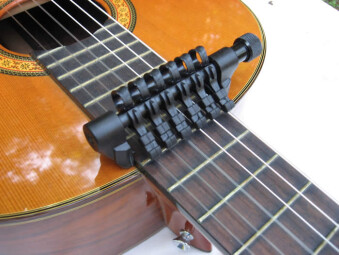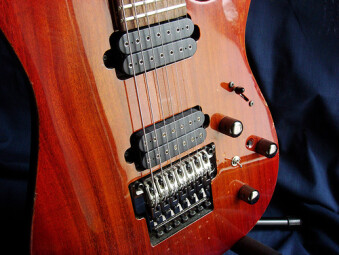A guitarist must frequently adapt to the voice of the singer and specially to his or her own vocal range. How should this be done?
The vocal range or tessitura refers to the register between the lowest and the highest note. And we only consider those notes that can be reached comfortably, which means without straining and damaging the vocal cords. To grasp the idea better, we could say that a 24-fret guitar has a three-octave range that spans from the lowest E to the highest E. The vocal range is not as wide, it usually covers only two octaves (and up to two and a half octaves for certain gifted and well-trained singers).
You guessed it, the vocal range isn’t easy to train and it takes many years of singing lessons to be able to extend it. That’s why, unless you are Mariah Carey or Chris Cornell, you’d better learn how to adapt your instrument to your (or your singer’s) vocal range, rather than risking an injury.
Let’s take a riff in E, for instance, and see where we can take it…

A capo
With a ridiculously low price (between $4 and $50) and an astounding ease of use, the capo allows you to play any song written in whatever key and transpose it to another one.

By artificially reducing the length of the neck, the capo transforms your standard tuning into whichever you want. In the example above, if we put the capo on the second fret we instantly get an F# tuning without a sweat. The only problem is that no capo can extend the neck of your guitar, so you can only transpose to higher keys.
For those who might be interested: there’s a capo that allows us to set every string individually (Creative Tunings XXL capo).
This is a folk guitar player’s first choice, but its not very rock-n-roll looking and the impossibility of transposing to lower keys may discourage some. Fortunately we have…
Open tunings
If you are into more aggressive electric guitar genres, open tunings is probably the way to go. The easiest to achieve and use is Drop D: you only need to tune down the low E string to make it a D. It’s ideal if the singer pushes into the highs more often than not.

But there are lots of other open tunings. Again a very cheap solution, considering that you only have to turn your tuners a bit.
A side note: if either of these methods works for you and the voices you accompany with your guitar and you wish to use it more often, do not hesitate to change the gauge of your strings. Capos don’t get along too well with very loose strings nor with open tunings (for example, if your standard E is 0.42, choose 0.46 if you are going to tune to D). Seven-string and baritone guitars are properly equipped by default. At worst, you risk some fretting at awkward moments, which is acceptable during a test or an individual song, but very annoying if it happens during a whole set.
But if you wish to keep the same chord positions while extending the range of your guitar into the lows there’s even another solution!
Seven-string and baritone guitars
If you have the means (and you are not afraid of big necks) these types of guitars offer no fewer than four additional notes in the low end. They are especially interesting for singers with deep voices, but also for high-pitched ones.

And you can always combine all these different methods to obtain an almost infinite number of possibilities. Nothing prevents you from using a capo on a baritone guitar tuned to open A!
Finally, even if you do not wish to use these techniques, try to take into consideration the natural vocal range of the person who’s making his or her precious vocal cords vibrate. He or she will be grateful.



